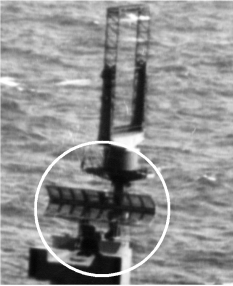![]() The Pacific War Online Encyclopedia
The Pacific War Online Encyclopedia
|
| Previous: Fast Seaplane Tenders (AVD) | Table of Contents | Next: FD Fire Control Radar |

Naval
History and Heritage Command #NH-10585-A
| Wavelength | 40 cm |
| Pulse Width | 1.5 microsecond |
| Pulse Repetition Frequency | 1640 Hz |
| Power | 15-20 kW |
| Range | 20,000 yards (18,000 meters) on 16" (400mm) shell splash 45,000 yards (41,000 meters) on bomber 12,000 yards (11,000 meters) on submarine |
| Antenna |
21' half cylinder with half wave dipole
emitters |
| Scope |
A scope |
| Accuracy | 40 yards (37 meters) 2 mils |
| Resolution | 1200 feet (370 meters) 10 degrees |
| Production: | 139 sets from 1941-10 to 1944. Standard on cruisers by 1943-6. |
The U.S. FC or Mark 3
fire control radar was known in British service as the
Type 284. It gave no height information, but used lobe switching
to achieve high directional accuracy. It was first tested in May
1941 and began to appear on Allied ships during the
Guadalcanal campaign. It
was FC radar that allowed Washington to
straddle Hiei with
its first salvo and rapidly render the Japanese battleship hors de
combat.
The sets were equipped with range gates, which, when activated, blocked returns except from a narrow window in range. The window could be set to be 500 or 1000 yards (460 or 910m) wide and was manually centered on the estimted range to target. This allowed very accurate determination of range, but could lead inexperienced operators to chase their own ship's fall of shot rather than the target, as may have occurred at the Battle of Tassafaronga.
By late 1944, FC was already obsolescent, having superceded by
the Mark 8.
This became painfully clear at Surigao
Strait, where the battleships still equipped with FC got off
very few salvoes.
References
Friedman
(1981)
Guerlac (1987)
The Pacific War Online Encyclopedia © 2008-2009, 2011 by Kent G. Budge. Index